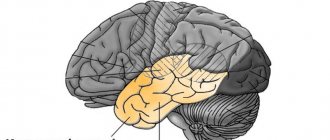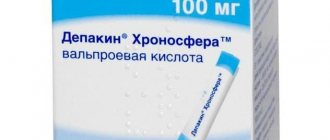Normotimics is a heterogeneous group of medications that are prescribed to stabilize mood in outpatient (supportive) psychiatry. Thymoisoleptics make it possible to prevent relapses and maintain remission over a long period of time in the treatment of, for example, bipolar affective disorder (BD), cyclothymia, schizophreniform disorder, schizoaffective psychosis, and moderate unipolar depression. Properly selected drugs in this group prevent or effectively smooth out mood swings, manic and depressive states.
The unique mechanism of action of mood stabilizers includes a double effect - they prevent or significantly mitigate affective phases and attacks of the schizoaffective structure, as well as depressive tendencies. This effect of lithium salts was first noticed in clinical practice in the first half of the 20th century. Some time later, in the mid-60s, Danish scientists Baastrup P. and Schou M. confirmed that lithium salts even out mood, while differing in their mechanism of action from antipsychotics and antidepressants. The discovery made it possible to initiate a discussion about the creation of a new group of drugs - mood stabilizers.
The final interest in drugs of this group arose in the late 70s, when active research began on the mechanisms of action of lithium salts, the search for analogues with desired properties, with less pronounced non-core effects and pronounced thymoisoleptic properties. In the late 80s, based on accumulated clinical experience and research results, the group of mood stabilizers began to include some anticonvulsants, antipsychotics, and tranquilizers with thymoleptic effects.
Classification of mood stabilizers
The International Anatomical Therapeutic Chemical Classification of Drugs (ATX) does not have a separate section for mood-boosting drugs. However, the classification indicates the normothimic properties of specific drugs, which, however, corresponds to the logic of its structure - according to the action profile.
Classification of mood stabilizers by chemical structure includes:
- lithium salts (carbonate, gluconate, sulfate, chloride, citrate, hydroxybutyrate, long-acting lithium preparations);
- carbamazepine derivatives;
- valproic acid derivatives;
- calcium channel blockers;
- some atypical antipsychotics;
- some benzodiazepine tranquilizers.
The phenomenon of amygdalar kindling
The presented groups consist of drugs with an anticonvulsant effect, which have a calming, mood-stabilizing effect. Their use in the psychiatry of reversible and borderline disorders is explained by a neurobiological hypothesis - the phenomenon of amygdala kindling. The hypothesis reflects ideas about the occurrence of epileptic seizures, associated, in particular, with the impact of psychological stimuli on the amygdala and limbic system of the brain. Their irritation at an individual superthreshold level, caused by emotional disturbances restrained and suppressed by a person, becomes the cause of epileptic seizures. Therefore, drugs of this group are effective for stopping not only convulsive activity, but also the underlying biochemical-psycho-emotional pathology, which causes a response from the same brain structures.
Rice. 1. One of the most complete classifications of mood stabilizers.
Mechanism of action of mood stabilizers
The mechanism of action of mood stabilizers has been studied quite well. However, the psychobiological effects that occur when taking mood stabilizers have, indeed, been virtually unstudied. Modern research on thymoisoleptics aims to fill the missing knowledge about drugs in this group, focusing on the study of the following processes:
- on the concomitant biochemistry of neurotransmitters that occurs against the background of the course of target diseases;
- on processes at the cellular level (for example, on the interaction of the ligand with receptors, proteins and second messengers);
- on the interaction of neurotransmitter systems with neurotransmitters;
- on circadian rhythms in the presence of specific psychopathology;
- on the genetic factor (on the role of heredity).
It is known that the therapeutic mechanism of action of mood stabilizers is associated with the effect on neurotransmitters - cholinergic, catecholaminergic, indolaminergic and the GABA system. In particular, the latest research indicates the presence of biochemical processes on post- and preneuronal receptors, post-receptor activity of the above neurotransmitters.
Rice. 2. The mechanism of action of mood stabilizers.
Cholinergic system
In affective disorders, changes in the cholinergic-adrenergic system are observed. For example, in manic states, cholinergic activity decreases relative to noradrenergic activity, and in depressive states, vice versa. Research shows that some mood stabilizers are able to equalize the concentration of choline in red blood cells, thereby achieving a therapeutic effect.
Catecholaminergic system
Some mood stabilizers reduce the level of thyroid hormone and dopamine, which can increase the activity of the catecholaminergic system, which is the cause of manic states. In particular, this mechanism of action of mood stabilizers is confirmed by studies that note an increase in thyroid activity during the development of manic states and its decrease during recovery.
Indolamines
The effects of some mood stabilizers on indoleamine neurotransmitters increase serotonin levels through agonism at postsynaptic serotonergic receptors and by promoting tryptophan reuptake.
Gamma-aminobutyric acid (GABA)
Gamma-aminobutyric acid (GABA) is not only the main inhibitory neurotransmitter of the central nervous system, but also an inhibitor of neurotransmitters. Some mood stabilizers are able to increase the level of GABA, which in turn evens out the imbalance of neurotransmitters, providing a therapeutic effect.
Unique effects of mood stabilizers
In addition to the therapeutic effect exerted through their influence on neurotransmitter systems, mood stabilizers, in particular, act on opiate and benzodiazepine receptors and suppress the activation of adenylate cyclase of cyclic adenosine and guanine monophosphates. Therefore, the mechanism of action of mood stabilizers determines the wide range of use of drugs in this group in almost all areas of medicine.
The variety of biochemical processes stimulated during treatment with mood stabilizers is still of interest to researchers - various hypotheses are being tested that try to explain their unique therapeutic effect, and new ones are being put forward. In clinical practice, this implies the responsibility of doctors when prescribing drugs of this group, especially during long-term treatment.
In addition to the wide range of use of mood stabilizers, drugs in this group exhibit another common effect that has important clinical significance - smoothing of circadian fluctuations. Unlike other psychotropic drugs, mood stabilizers normalize ri, for example, in the treatment of manic states, as well as in the process of preventive therapy.
Rice. 3. Circadian rhythm.
Carbamazepine
Carbamazepine is widely loved by neurologists, psychiatrists and narcologists. Various neuralgia, bipolar disorder, mood disorders due to damage to the central nervous system, alcohol dependence and withdrawal syndrome, and so on and so forth. Carbamazepine is dear to the hearts of many specialists and is prescribed for a wide variety of conditions. It should be taken into account that carbamazepine reduces the concentration of antipsychotics (neuroleptics) and antidepressants in the patient’s blood, which can lead to a worsening of the condition when carbamazepine is added. Like other mood stabilizers, carbamazepine is prescribed for aggression and impulsivity if they arise from a mental disorder.
Side effects of carbamazepine:
- weakness, lethargy;
- nausea;
- dizziness;
- skin rash;
- decrease in the number of leukocytes in the blood (especially at the beginning of therapy).
Indications for the use of mood stabilizers
In clinical practice, when prescribing mood stabilizers, they are guided by the degree of severity of the necessary therapeutic effects of a particular drug. In particular, the characteristics of the course of the disease, health status and lifestyle of the patient are taken into account. And although the therapeutic mechanism of action of all thymoisoleptics is reduced to mood stabilization, specific indications for prescribing mood stabilizers still exist (below will be given the features of the therapeutic effects of some drugs in terms of prescription in the treatment of target psychopathology).
Lithium
Lithium salts are the most famous representatives of this group of drugs. Indications for the use of lithium-based mood stabilizers include:
- bipolar affective disorder;
- severe forms of depression;
- resistant forms of depression;
- affective psychoses;
- other affective disorders.
In particular, lithium preparations are used in the treatment of mood disorders in chronic alcoholism; in dermatology - for viral infections, seborrheic dermatitis, mycoses; in neurology - a positive therapeutic effect is noted in the treatment of amyotrophic lateral sclerosis (degenerative processes are slowed down).
Valproic acid
Valproic acid has a pronounced antimanic effect. The antidepressant effect manifests itself, as a rule, in the treatment of mixed conditions, when depression occurs in parallel with mania.
Preparations based on valproic acid are used in the clinic for the following mental disorders:
- bipolar affective disorder;
- schizophrenia (in complex psychopharmacotherapy);
- dopamine dysregulation syndrome;
- tension headaches.
Valproic acid drugs are first-line drugs in the treatment of epilepsy (tonic-clonic seizures, myoclonic seizures, absence of seizures).
Carbamazepine
Carbamazepine is a universal mood stabilizer due to its weak antimanic effect and dominant anti-anxiety and antidepressant effect. The drug is able to improve mood, promote mental activity, smooth out hot temper and irritability. Typically, the indication for its use is depression, accompanied by anxiety, lethargy, loss of strength and tearfulness.
In addition, carbamazepine is the first-line drug for the treatment of trigeminal neuralgia; in narcology - in the treatment of withdrawal states accompanied by convulsions, vegetative and mental disorders.
Oxcarbamazepine
Oxcarbamazepine has a weak sedative effect and a pronounced antimanic effect, allowing you to cope with tremor. As a rule, it is prescribed in the presence of manic phases in the structure of depressive states, bipolar affective disorder.
Lamotrigine
Lamotrigine is effective in the treatment of bipolar affective disorder type I with severe depressive phases; The antimanic effect is quite weak. Used in combination with SSRIs to treat depersonalization-derealization syndrome, borderline personality disorder, schizoaffective disorder, resistant OCD, and hallucinogen-induced disorders.
Rice. 4. The use of mood stabilizers in the treatment of mental disorders with manic states.
DEPAKIN CHRONO
special instructions
Before starting the use of the drug Depakine® chrono and periodically during the first 6 months of treatment, especially in patients at risk of developing liver damage, liver function tests should be performed.
As with the use of most antiepileptic drugs, when using valproic acid, a slight increase in the activity of liver enzymes is possible, especially at the beginning of treatment, which occurs without clinical manifestations and is transient. In these patients, a more detailed study of biological parameters, including the prothrombin index, is necessary, and dose adjustment of the drug may be required, and, if necessary, repeated clinical and laboratory examinations.
Before starting therapy or before surgery, as well as in the event of spontaneous occurrence of subcutaneous hematomas or bleeding, it is recommended to determine the bleeding time and the number of formed elements in the peripheral blood, including platelets.
Severe liver damage
Predisposing factors
There have been isolated reports of severe liver damage, sometimes fatal. Clinical experience shows that patients at risk are those taking multiple antiepileptic drugs at the same time; infants and children under three years of age with severe seizures, especially in the setting of brain damage, mental retardation and/or congenital metabolic or degenerative diseases; patients concomitantly taking salicylates (since salicylates are metabolized through the same metabolic pathway as valproic acid).
After the age of three, the risk of liver damage decreases significantly and decreases progressively as the patient ages. In most cases, such liver damage occurred during the first 6 months of treatment, most often between 2 and 12 weeks of treatment and usually when valproic acid was used as part of combination antiepileptic therapy.
Symptoms suspicious for liver damage
For early diagnosis of liver damage, clinical observation of patients is mandatory. In particular, you should pay attention to the appearance of the following symptoms, which may precede the onset of jaundice, especially in patients at risk (see above):
- nonspecific symptoms, especially those that began suddenly, such as asthenia, anorexia, lethargy, drowsiness, which are sometimes accompanied by repeated vomiting and abdominal pain;
- resumption of seizures in patients with epilepsy.
Patients or their family members (when using the drug in children) should be warned that they should immediately report the occurrence of any of these symptoms to their doctor. Patients should immediately undergo clinical examination and laboratory testing of liver function tests.
Revealing
Liver function tests should be performed before starting treatment and then periodically during the first 6 months of treatment. Among conventional studies, the most informative are studies reflecting the state of the protein-synthetic function of the liver, especially the determination of the prothrombin index. Confirmation of deviation from the norm of the prothrombin index in the direction of its decrease, especially in combination with deviations from the norm of other laboratory parameters (a significant decrease in the content of fibrinogen and blood clotting factors, an increase in the concentration of bilirubin and an increase in the activity of “liver” transaminases), as well as the appearance of other symptoms indicating for liver damage (see above), requires discontinuation of the drug Depakine® Chrono. As a precaution, if patients were taking salicylates concomitantly, their use should also be discontinued.
Pancreatitis
There are rare reported cases of severe forms of pancreatitis in children and adults, which developed regardless of age and duration of treatment. Several cases of hemorrhagic pancreatitis have been observed with rapid progression of the disease from the first symptoms to death.
Children are at increased risk of developing pancreatitis, and this risk decreases as the child ages. Risk factors for developing pancreatitis may include severe seizures, neurological disorders, or anticonvulsant therapy. Liver failure combined with pancreatitis increases the risk of death.
Patients who experience severe abdominal pain, nausea, vomiting and/or anorexia should be evaluated immediately. If the diagnosis of pancreatitis is confirmed, in particular with increased activity of pancreatic enzymes in the blood, the use of valproic acid should be discontinued and appropriate treatment should be initiated.
Female children and adolescents, women of childbearing potential and pregnant women
Depakine® Chrono should not be used in female children and adolescents, women of childbearing potential and pregnant women, unless alternative treatments are ineffective or not tolerated. This limitation is associated with a high risk of teratogenicity and mental and physical development disorders in children who were exposed to valproic acid in utero. The benefit/risk ratio should be carefully re-evaluated in the following cases: during regular review of treatment, when a girl reaches puberty and, urgently, if a woman taking valnroic acid plans or becomes pregnant.
During treatment with valproic acid, women of childbearing potential should use reliable methods of contraception, and they should be informed of the risks associated with taking Depakine Chrono during pregnancy (see section "Use during pregnancy and breastfeeding"). To help the patient understand these risks, the physician prescribing valproic acid should provide the patient with comprehensive information about the risks associated with taking Depakine Chrono during pregnancy.
In particular, the physician prescribing valproic acid should ensure that the patient understands:
- the nature and magnitude of the risks when using valproic acid during pregnancy, in particular, the risks of teratogenic effects, as well as the risks of disorders of the mental and physical development of the child;
— the need to use effective contraception;
- the need for regular review of treatment;
- the need for urgent consultation with her doctor if she suspects that she is pregnant, or when she suspects the possibility of pregnancy.
A woman planning a pregnancy should definitely try, if possible, to switch to an alternative treatment before she attempts to conceive (see section “Use during pregnancy and breastfeeding”). Treatment with valproic acid should be continued only after a physician experienced in the treatment of epilepsy and bipolar disorders has re-evaluated the benefits and risks of treatment.
Suicidal thoughts and attempts
Suicidal thoughts and attempts have been reported in patients taking antiepileptic drugs for some indications. A meta-analysis of randomized placebo-controlled trials of antiepileptic drugs also showed a 0.19% increase in the risk of suicidal ideation and attempts in all patients taking antiepileptic drugs (including a 0.24% increase in this risk in patients taking antiepileptic drugs for epilepsy ), compared with their frequency in patients taking placebo. The mechanism of this effect is unknown.
Therefore, patients taking the drug Depakine® Chrono should be constantly monitored for suicidal thoughts and attempts, as well. if they occur, appropriate treatment must be carried out. Patients and caregivers are advised to seek immediate medical attention if a patient experiences suicidal thoughts or attempts.
Carbapenems
Concomitant use of carbapenems is not recommended (see section “Interaction with other drugs”).
Patients with known or suspected mitochondrial diseases
Valproic acid can initiate or aggravate the manifestations of the patient's mitochondrial diseases caused by mutations in mitochondrial DNA, as well as in the nuclear gene encoding the mitochondrial enzyme γ-polymerase (POLG). In particular, in patients with congenital neurometabolic syndromes caused by mutations in the gene encoding polymerase γ (POLG); for example, in patients with Alpers-Huttenlocher syndrome, valproic acid use was associated with a higher incidence of acute liver failure and liver-related deaths. Diseases due to γ-polymerase defects may be suspected in patients with a family history of such diseases or symptoms suggestive of their presence, including unexplained encephalopathy, refractory epilepsy (focal, myoclonic), status epilepticus, mental and physical retardation, psychomotor regression, axonal sensorimotor neuropathy, myopathy, cerebellar ataxia, ophthalmoplegia or complicated migraine with visual (occipital) aura and others.
In accordance with current clinical practice, testing for mutations in the polymerase γ gene (POLG) should be performed to diagnose such diseases (see section “Contraindications”).
Increased seizures
As with other antiepileptic drugs, when taking valproic acid, some patients experienced, instead of improvement, a reversible increase in the frequency and severity of seizures (including the development of status epilepticus) or the appearance of new types of seizures. If seizures worsen, patients should immediately consult their doctor (see section “Side Effects”).
Children (information refers to dosage forms of the drug Depakine® that can be taken by children under three years of age)
In children under three years of age, if it is necessary to use the drug, it is recommended to use it in monotherapy and in the dosage form recommended for children. However, before starting treatment, you should weigh the ratio of the potential benefits of using valproic acid and the risk of liver damage and the development of pancreatitis when using it.
In children under 3 years of age, the simultaneous use of valproic acid and salicylates should be avoided due to the risk of liver toxicity.
Kidney failure
It may be necessary to reduce the dose of valproic acid due to an increase in the concentration of its free fraction in the blood serum. If it is impossible to monitor plasma concentrations of valproic acid, the dose of the drug should be adjusted based on clinical observation of the patient.
Enzyme deficiency of the carbamide cycle (urea cycle)
If an enzymatic deficiency of the carbamide cycle is suspected, the use of valproic acid is contraindicated. Several cases of hyperammonemia with stupor or coma have been described in such patients. In these cases, metabolic studies should be carried out before starting treatment with valproic acid (see section "Contraindications").
In children with unexplained gastrointestinal symptoms (anorexia, vomiting, cases of cytolysis), a history of lethargy or coma, with mental retardation, or a family history of death of a newborn or child, metabolic studies should be carried out before starting treatment with valproic acid, in particular, determination of ammonemia (presence of ammonia and its compounds in the blood) on an empty stomach and after meals (see section “Contraindications”).
Patients with systemic lupus erythematosus
Although it has been shown that during treatment with Depakin® Chrono, dysfunction of the immune system is extremely rare, the potential benefits of its use must be compared with the potential risks when using the drug in patients with systemic lupus erythematosus.
Weight gain
Patients should be warned about the risk of weight gain at the beginning of treatment, and measures, mainly dietary, should be taken to minimize this phenomenon.
Patients with diabetes mellitus
Given the possibility of adverse effects of valproic acid on the pancreas, when using the drug in patients with diabetes mellitus, blood glucose concentrations should be carefully monitored. When testing urine for the presence of ketone bodies in patients with diabetes, it is possible to obtain false-positive results, since valproic acid is excreted by the kidneys, partly in the form of ketone bodies.
Patients infected with human immunodeficiency virus (HIV)
In in vitro
Valproic acid has been found to stimulate HIV replication under certain experimental conditions.
The clinical significance of this fact, if any, is unknown. Additionally, the significance of these in vitro
for patients receiving maximally suppressive antiretroviral therapy has not been established. However, these data should be taken into account when interpreting the results of continuous viral load monitoring in HIV-infected patients taking valproic acid.
Patients with existing deficiency of carnitine palmitoyltransferase (CPT) tin II
Patients with existing CPT type II deficiency should be warned of the increased risk of rhabdomyolysis when taking valproic acid.
Ethanol
During treatment with valproic acid, ethanol consumption is not recommended.
Other special instructions
The inert matrix of the drug Depakine® chrono (extended release drug), due to the nature of its excipients, is not absorbed in the gastrointestinal tract; after the release of the active substances, the inert matrix is excreted in the feces.
One tablet of Depakine® Chrono 300 mg contains 1.2 mmol (27.6 mg) sodium. One tablet of Depakine® Chrono 500 mg contains 2 mmol (46.1 mg) sodium. This must be taken into account in patients on a strict low sodium diet.
Side effects of mood stabilizers
To avoid side effects of mood stabilizers, it is necessary to select the minimum effective dosage under the supervision of the attending physician. If non-core actions occur, the attending physician will correct the treatment. Refusal of treatment or independent adjustment of the dosage of the drug taken is unacceptable.
The main side effects of mood stabilizers include:
- nausea;
- drowsiness;
- lethargy;
- muscle weakness;
- slurred speech;
- dizziness;
- double vision.
Drug selection stage
The reaction of patients to taking mood stabilizers is individual. It depends, for example, on the characteristics of the course of the disease and state of health. At the stage of drug selection and dosage, short-term (reversible) side effects of mood stabilizers may occur. Therefore, the patient needs to note unusual sensations and conditions and promptly notify the attending physician about them, for example:
- about daytime sleepiness;
- about mild muscle weakness;
- about difficulty concentrating.
A personalized approach to drug selection, associated with the occurrence of side effects of mood stabilizers, should not become a reason for refusing treatment. On the contrary, a correctly selected mood stabilizer will allow you to avoid the increased intensity of non-core effects of drugs from other groups.
Valproic acid
Valproic acid is usually taken in the form of sodium salts - sodium valproate. This compound itself is unique in psychiatry in that it does not contain a cyclic part of carbon and other atoms. Valproic acid is widely used for various types of epilepsy, but it also has a place in psychiatry. The main indication is BAR. Valproic acid and its salts are used to treat the manic phase of bipolar disorder and for maintenance therapy in this disease. A number of researchers believe that valproic acid may be especially effective during rapid phase changes and mixed conditions within the framework of bipolar disorder.
A separate area of use of valproic acid is the suppression and prevention of aggression, emotional instability, impulsivity and self-harm, which may be useful in borderline personality disorder. Valproic acid is also used to enhance the effect of antipsychotics.
The main side effects of valproic acid, which usually lead to drug discontinuation, are:
- weight gain;
- digestive problems (nausea, vomiting, diarrhea and cramps) - these adverse events are usually dose-dependent: the higher the dose of the drug taken, the more severe the side effects;
- drowsiness and lethargy;
- liver damage.
Recently, doctors have been actively discussing the harm of valproic acid to the fetus if the mother takes valproic acid during pregnancy. It must be said that other mood stabilizers do not have any advantage in this regard over valproic acid.
List of mood stabilizers
Currently, the list of mood stabilizers may include not only names with a combined antidepressant and antimanic effect, but also only those with a mood-stabilizing effect (for example, lamotrigine does not have antimanic activity). In addition, the additional properties of some mood stabilizers expand the range of the group’s therapeutic profile, making it possible to prescribe such drugs in the treatment of mental disorders that include anxiety and panic symptoms.
Mineral salts
The list of mood stabilizer drugs includes various names, the active ingredient of which is:
- lithium carbonate;
- lithium gluconate;
- lithium chloride;
- lithium citrate;
- lithium oxybate;
- long-acting forms of lithium;
- rubidium chloride;
- Cesium chloride.
Anticonvulsants with normothimic activity
Anticonvulsant medications from the list of mood stabilizers include:
- Carbamazepine;
- Oxcarbazepine;
- Valproic acid;
- Lamotrigine;
- Gabapentin;
- Levetiracetam.
Atypical antipsychotics
Atypical antipsychotics belonging to the list of mood stabilizers are represented by the following names:
- Aripiprazole;
- Asenapine;
- Risperidone;
- Olanzapine;
- Quetiapine;
- Clozapine.
Calcium antagonists
Calcium antagonists are:
- Verapamil;
- Nifedipine;
- Nimodipine.
Thyroid hormones
As a rule, thyroid hormones are included in the list of mood stabilizers on the principle of additional therapy when discontinuation of antidepressants is required:
- Triiodothyronine;
- L-thyroxine.
List of used literature
1. Mazo G.E. “Normotimiki in the treatment of treatment-resistant depression: anti-resistant therapy or influence on latent bipolarity?”
2. Marilov V.V., Sologub M.B. “Comparative effectiveness of mood stabilizers in complex therapy of bulimia nervosa.”
3. Malin D.I. "Drug interactions of drugs used in psychiatric practice."
4. Aleksandrovsky Yu.A. "Rational pharmacotherapy in psychiatric practice: a guide for practitioners."
5. Maslov K.A. “Normotimiki in Russia in modern clinical practice of a psychiatrist.”
6. Arana D., Rosenbaum D.F. "Guide to psychopharmacotherapy."
7. Amir O. “Normotimiki.”
Share
Share
Lithium carbonate
In Russia, lithium carbonate is the only representative of lithium salts. In the USA they still use lithium citrate, but in Russia it is not used. Lithium carbonate is used in bipolar and schizoaffective disorder to relieve manic episodes and as a maintenance therapy. It may also be useful in reducing irritability in patients with mental disorders. The addition of lithium carbonate to antidepressant therapy can enhance their effect, although doctors are currently using other methods to overcome the insufficient effect of antidepressants. Another strength of lithium salts is that, according to some data, they can reduce the risk of suicide in patients with depression.
To assess the effectiveness and safety of therapy with lithium salts, it is customary abroad to evaluate the concentration of lithium ions in the blood. Such an analysis is available in our country, but it is performed by private laboratories and at the expense of the patient or his relatives.
The following are usually mentioned as side effects of lithium drugs:
- hand tremors;
- lethargy, memory loss;
- skin rash, acne or hair loss;
- renal dysfunction.
The drug is quite widely used in the practice of psychiatrists due to its strong and relatively quickly developing effect.
Unlike lithium salts, other mood stabilizers are classified as anticonvulsants - drugs used to treat epilepsy. Examples include valproic acid, carbamazepine and lamotrigine.
Cost of treatment in our clinic
| Service | Price | |
| Ambulatory treatment | ||
| Psychiatrist consultation | 4 500 ₽ | |
| Consultation with a psychotherapist | 4 500 ₽ | |
| Psychodiagnostics extended | 7 000 ₽ | |
| Consultation with a psychiatrist at home | 6 000 ₽ | |
| Treatment in hospital | ||
| Delivery to hospital | For free | |
| Standard room | 7 700 ₽ | |
| 3-bed superior room | 10 600 ₽ | |
| 2-bed superior room | 13 700 ₽ | |
| 1 local VIP chamber | 19 000 ₽ | |
| Doctor's appointment 2 weeks after discharge | For free | |









